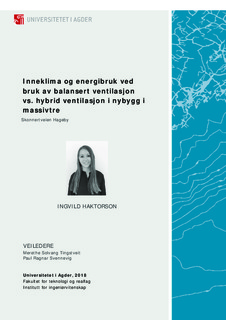| dc.contributor.author | Haktorson, Ingvild | |
| dc.date.accessioned | 2018-09-17T09:26:54Z | |
| dc.date.available | 2018-09-17T09:26:54Z | |
| dc.date.issued | 2018 | |
| dc.identifier.uri | http://hdl.handle.net/11250/2562900 | |
| dc.description | Masteroppgave bygg BYG508 - Universitetet i Agder 2018 | nb_NO |
| dc.description.abstract | Most apartment buildings today are installed with mechanical balanced ventilation. A measure to
reduce energy consumption and still satisfy the demand for heating is to apply hybrid ventilation. That
includes using natural driving forces whilst reducing the use of mechanical ventilation. Furthermore,
indoor climate in buildings is important because it has a major impact on human health, productivity
and comfort. There is an increasing use of Cross-laminated timber (CLT) in Norway. However, there is
little research on how CLT affects the indoor climate. The purpose of this master thesis is to investigate
how balanced ventilation and hybrid ventilation affect the indoor climate and energy consumption in
a CLT apartment building. The simulation tool IDA ICE was used to compare mechanical balanced
ventilation with hybrid ventilation. In addition, measurements of the indoor climate with balanced
ventilation were done in “Skonnertveien Hageby” and a survey was conducted with the residents to
investigate the correlation between measurable tests and perceived comfort. The simulation states
that when replacing balanced ventilation with hybrid ventilation in the CLT-building, energy
consumption is reduced from 67.6 kWh/m2 to 39.7 kWh/m2. The results also show that the highest
operative temperature drops from 30.6°C to 27.6°C with hybrid ventilation. However, hybrid
ventilation has been shown to have a higher concentration of CO2, with values up to 1370.5 ppm. This
indicates that in order to achieve satisfactory air quality, the airflow would need to be increased.
Maximum relative humidity is also slightly higher for hybrid ventilation compared to balanced
ventilation. The results from the measurements show that the thermal and atmospheric climate in
“Skonnertveien Hageby” is largely satisfactory. This also correlates with the results from the survey,
where most of the residents are satisfied. The surface temperature is largely similar to the air
temperature in the room, which indicates that CLT can contribute to steady temperatures. According
to the measurements, CLT might have a positive impact on thermal comfort, relative humidity and
indoor air quality, mainly due to its high thermal capacity. | nb_NO |
| dc.language.iso | nob | nb_NO |
| dc.publisher | Universitetet i Agder ; University of Agder | nb_NO |
| dc.rights | Attribution-NonCommercial-NoDerivatives 4.0 Internasjonal | * |
| dc.rights.uri | http://creativecommons.org/licenses/by-nc-nd/4.0/deed.no | * |
| dc.subject | BYG508 | nb_NO |
| dc.title | Inneklima og energibruk ved bruk av balansert ventilasjon vs. hybrid ventilasjon i nybygg i massivtre : Skonnertveien Hageby | nb_NO |
| dc.type | Master thesis | nb_NO |
| dc.subject.nsi | VDP::Teknologi: 500::Bygningsfag: 530::Arkitektur og bygningsteknologi: 531 | nb_NO |
| dc.source.pagenumber | 188 s. | nb_NO |

